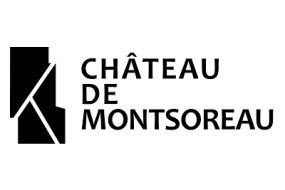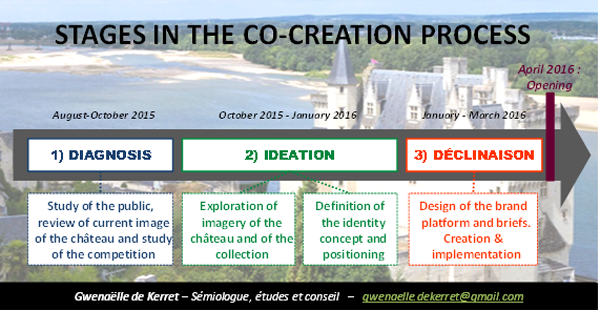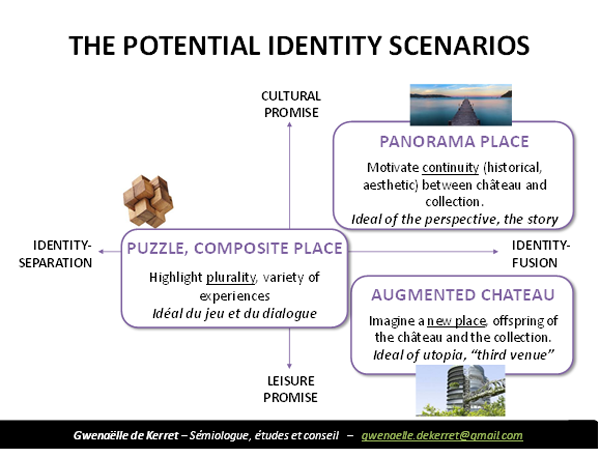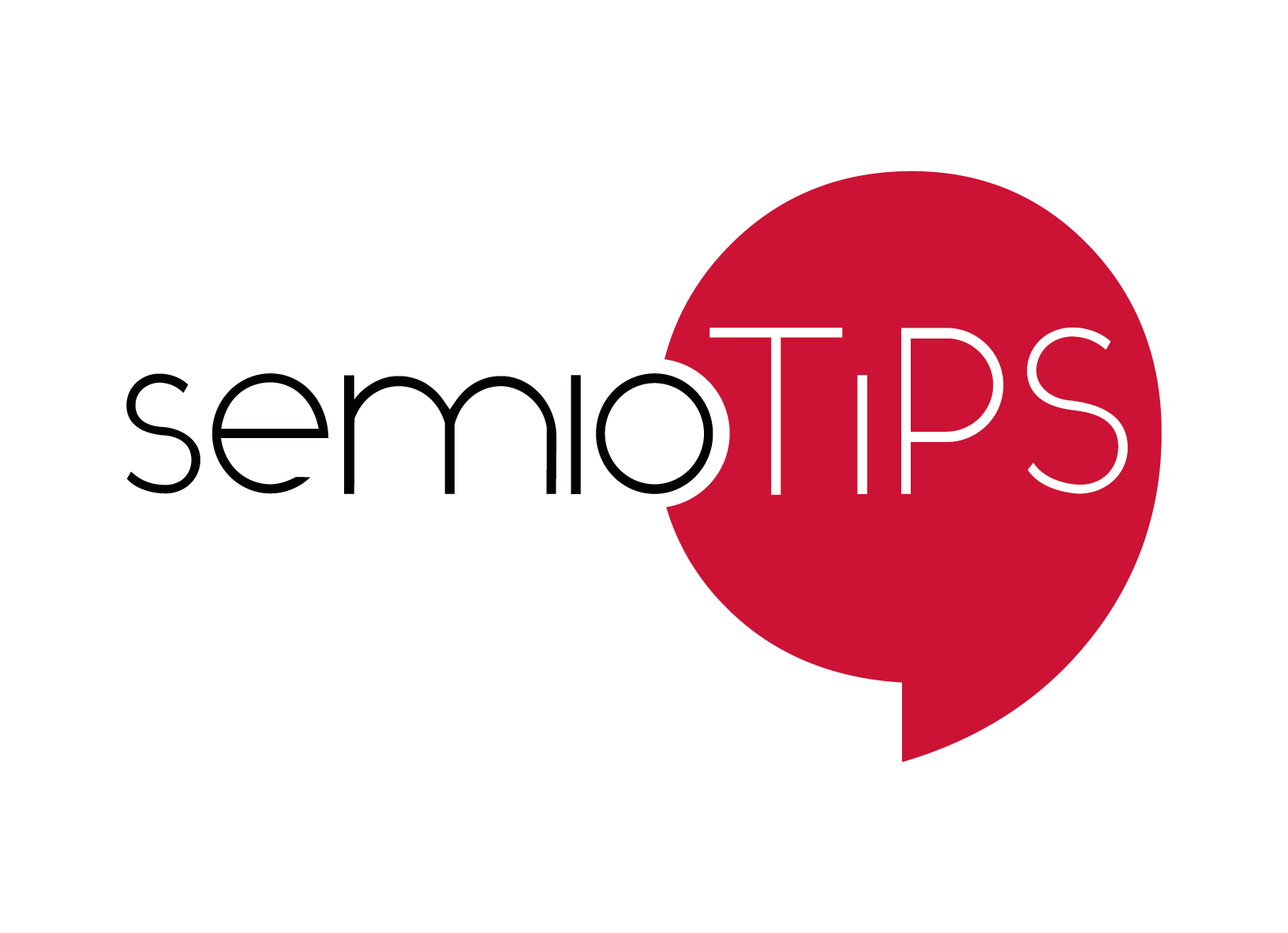The Château de Montsoreau re-opened in April of 2016, with the installation of the Philippe Méaille collection. The locations is now devoted to contemporary art. To help define the Château’s new identity, “co-creation” assistance was sought. Now that the opening is accomplished, how does the site look? Here’s a glance at already visible signs of change and some feedback on the process that helped it to happen.
On the road that runs alongside the Loire River between Saumur and Tours, a new symbol is gradually emerging amidst the road signage. For its re-opening, the Château de Montsoreau has adopted a new logo, an icon for the metamorphosis that has turned this historic part of French patrimony into a venue devoted to contemporary art. The movement known as Art & Language, created by a collective of conceptual artists, now has pride of place at the château, thanks to collector Philippe Méaille.

Expressing the new identity
Let’s take a closer look at the logo. Its distinctive form, apparently abstract, evokes several features of the Château de Montsoreau that differentiate it from the other Loire châteaux. First, it indicates geographic location, at the confluence of the Loire and the Vienne river: the white lines sketched out by the three flat black areas suggest its exceptional location, overlooking the Loire Valley scenery. The logo also refers metonymically to the architecture of the château: look closely and you can see the asymmetrical outlines of the east tower. Most importantly, the three shaded areas express the new positioning that has been determined for the château: a “puzzle place” combining architecture, history, art and leisure. Visitors can choose one or more of these activities “à la carte”.
The logo is the fruit of creative work carried out with several students from the Le Mans School of Fine Arts. It is also one of the results of the strategic process accomplished over a period of several months with collector Philippe Méaille, the artists, the Maine et Loire department and the Le Mans School of Fine Arts. This strategic planning process led to determining the identity of the château-museum.
A Design Thinking approach
The design of the identity of the new Château de Montsoreau had to meet two challenges: creating a link between the place of history and a provocative contemporary art collection; and continuing to attract a wide variety of tourists while also appealing to art museum enthusiasts. People also needed to be informed and reassured about one of the most complex collections in the history of art, showing that beyond its intellectual aspect, the works by Art & Language generate a new type of interaction with their audience.
The approach drew inspiration from Design Thinking. From semiological exploration to strategic planning, several methods were put in place to understand the environment and define the stakes involved in creating the future identity. More generally, the principle was one of co-creation, whereby both positioning and strategy were determined collaboratively, bringing in all the players involved with the museum. These included the sponsors of course (collector, regional authority), but also the artists, art specialists and the general public.
In compliance with Design Thinking principles, the method was based on a multidisciplinary and “agile” process, alternating phases of analysis, creativity and design. This approach, still not so common in the world of businesses and brands, is exceptional for a cultural institution. In museums and art galleries, communications strategies and interfaces are generally conceived of behind closed doors. The public is only questioned occasionally.
The steps in the process
The co-creation process for the new identity consisted of several stages, set up between August, 2015 and March, 2016:

The first phase, Diagnostic, aimed to ascertain what the public thought of and expected from the château, and to understand the competitive environment. The second phase, Ideation, consisted in generating the maximum number of ideas. In addition to interviews with the sponsors, focus groups were held at the Le Mans School of Fine Arts. Two workshops were then orchestrated: the participants worked on the various aspects of the project, from visual communications to museographic approaches.
All the work was then subjected to semiological decoding, to determine the potential strategic directions. Three scenarios were thus envisioned:

The “Composite, puzzle” scenario was ultimately chosen. It appeared to be the one best able to enhance the project, and it reflected the appeal of the works by Art & Language, which are based on play, freedom and interaction.
The final stage, Adaptation, completed the process. The scenario was adapted into a “brand platform”. The main strategic elements were determined: an original promise; a “brand personality” and values; a targeting strategy, adapting the benefits of a visit to the site; finally, a territory of expression. The specifications lists for visual identity and mediation were then developed.
A model to be followed?
Philippe Méaille’s curatorial project for the Château de Montsoreau is an ambitious one. The same can be said for the co-creative approach implemented. In a sense, it reinvents the utopia of André Malraux’s “imaginary museum”, capable not only of reinventing the relationship with art but also of rethinking the cultural site as a space for social interaction. By soliciting the entire human chain involved in the project, from collector to general public, co-creation enabled the building not of a cultural product, but of a collaborative playing field between the project’s managers and beneficiaries.
We can only hope that the initiative will be repeated at other sites, and wish the Château de Montsoreau the very best in its new venture.
Testimonial from Philippe Méaille, collector and project manager
“The assistance we received (...) made a big contribution to the project’s implementation and finalisation. It enriched our thinking with a knowledge of the various publics concerned, along with their needs and expectations. Moreover, the work facilitated the conceptualisation of the cultural project and the visual identity”
Gwenaëlle de Kerret is a Semiologist and Research Director. After spending 11 years with market research firms (BVA, Harris Interactive), she now works as a consultant and helps organisations to evaluate their interface with their audiences and to implement change. Her expertise benefits from a broad experience in companies and government entities, and an in-depth knowledge of cultural institutions. In 2016, Gwenaëlle de Kerret completed a thesis in the field of information and communications sciences, focussed on the visual identity of museums in France and the USA.


